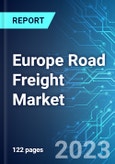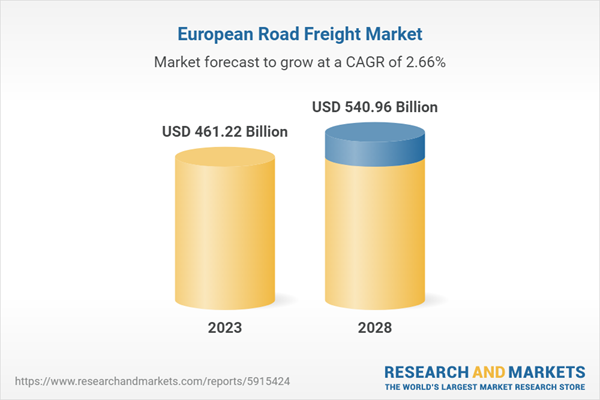Road freight refers to the movement of goods and supplies by road, using vehicles specifically designed for carrying heavy loads. The European road freight market is associated with the transportation of goods and commodities (raw materials or manufactured goods including both solids and liquids) from origin to destination within the country or across the European continent via road networks. The Europe road freight market value stood at US$461.22 billion in 2022 and is expected to reach US$540.96 billion by 2028. Europe's road freight market volume is expected to reach 1949.61 billion tonne-kilometres by 2028.
Europe road freight market demonstrated a consistent growth, owing to the strong performance of the European economy, rapidly expanding end user industries, increasing demand for road freight solutions in intermodal transportation, rising cross-border trade activities, the growing popularity of online shopping, and rising focus of manufacturers and retailers on core competencies. Also, efficient management of custom, distribution, warehousing, and order fulfillment by road freight companies, increasing demand for faster delivery services, positive shift towards third-party logistics (3PL) and contract logistics services, and increasing number of strategic partnerships and collaborations among logistics providers and manufacturers, is expected to boost the growth of Europe road freight market over the years. The market value is expected to grow at a CAGR of 2.66% over the projected period of 2023-2028.
Market Segmentation Analysis:
By Destination: The report provides the bifurcation of the Europe road freight market into two segments based on destination: domestic, and international and cross border. Domestic road freight is the largest segment of the European road freight market owing to rapidly expanding online retailing sectors, increasing need for efficient supply chain management, rapid urbanization, presence of well-developed and maintained road infrastructure, ongoing developments of autonomous vehicle technologies, and increasing number of companies outsourcing their logistics operations to third-party providers. International and cross border road freight is the fastest growing segment of Europe road freight market as a result of increase in trading activities due to globalization, expansion of the European Union (EU), an increasing number of trade agreements within the EU, and customs union arrangements, the close geographical proximity of European countries, and increasing adoption of digital technologies and automation solutions in road freight logistics.
By End User: The report provides the bifurcation of the Europe road freight market into five segments on the basis of end user: manufacturing, food and beverage, retail, metal and mining, and others. Food and beverage is the largest and fastest growing segment of the Europe road freight market as a result of the rapidly expanding online retailing sector, increasing consumption of organic and packaged food items among the growing urban population, increase in income levels, well-established retail distribution networks, increasing demand for cold chain solutions, European consumer’s strong preferences for locally-produced food and beverages, and road freight's flexibility in allowing quick adjustments to meet these seasonal and event-driven demands.
By Region: The report provides insight into the European road freight market, based on the nine regions namely, Germany, the UK, France, Spain, Italy, Netherlands, Poland, Switzerland, and the rest of Europe. Germany is the largest region of Europe's road freight market, as a result of the increasing presence of bilateral relations and trade agreements with neighboring European countries like France, well maintained supply chain infrastructure, country being a leader in the European region in terms of trade volumes, rapidly expanding automotive sector, high cabotage rates, booming industrialization, revised trade policies, presence of about 35,000 road freight companies in the region, rising modal share of road transport, and an increasing fleet of vehicles in the region. Spain is the fastest growing region of Europe's road freight market, as a result of rising demand for last-mile delivery services, the importance of just-in-time manufacturing & supply chain efficiency, the country's role as a major player in international trade, urbanization & population density, improving road infrastructure & transportation networks, the growing importance of road freight solutions in intermodal transportation, rising trade patterns and the construction of smooth expressways.
Market Dynamics:
Growth Drivers: The European road freight market has been rapidly growing over the past few years, due to factors such as increasing demand for third party logistics services, positively growing e-commerce sector, increase in cross-border trade, the rising contribution of road freight in intermodal transportation, surging demand for fast-delivery services, etc. Also, with growing need for efficient road transportation by major companies and organizations to expand their operations and source materials, components, and finished products from other countries efficiently and cost-effectively, there has been a surge in the number of logistics and road freight companies investing in expanding and improving road freight infrastructure such as highways and logistics centers, that are better equipped to handle increased cross-border trade. Furthermore, road freight services offer last-mile delivery services and a high level of flexibility, allowing companies to transport goods directly from the point of origin to the destination without the need for intermediate handling, boosting the growth of the European road freight market in the forecasted period.
Challenges: However, European road freight market growth would be negatively impacted by various challenges such as high fuel prices and road freight rates, stringent government regulations, etc. Cost increases in the European road freight market have continued to rise and the spot rates and contract rates continue to increase over time as a result of high fuel prices, forcing various small road freight providers, especially the owners and operators of trucks, to go out of business as it becomes very difficult for these carriers to pass on the increased costs to customers through higher freight rates, especially in the times of intensified competition among road freight carriers.
Trends: The market is projected to grow at a fast pace during the forecasted period, due to increasing focus on improving last-mile delivery, growing emphasis on sustainability, rising popularity of RFID tags, ongoing technological advancements, etc. Many companies in Europe are increasingly adopting sustainability as a core value and are often willing to pay a premium for transportation services that align with their sustainability goals, encouraging the road freight industry to invest in greener technologies and practices. Furthermore, the use of smart automated lockers such as in public places or retail stores, that allow customers to pick up their packages at their convenience, and real-time tracking systems that provide customers and logistics companies with accurate information about the location and estimated delivery time of their packages is likely to improve the operational efficiency of cargo deliveries, augmenting the demand for efficient & reliable road freight transportation services, boosting the growth of Europe road freight market in the forecasted period.
Impact Analysis of COVID-19 and Way Forward:
COVID-19 brought in many changes in the world in terms of reduced productivity, loss of life, business closures, closing down of factories and organizations, and shift to an online mode of work. Lockdowns, travel restrictions, and increasing disruptions in global supply chains reduced demand for transportation services, especially during the initial phases of the pandemic, negatively impacting the European road freight market during the period 2019-2020. The outbreak of the COVID-19 pandemic resulted in flight cancellations, closure of national and international borders, travel bans, and quarantines, which made massive slowing of the supply chain and logistics activities in the region, negatively impacting the operations and efficacy of European road freight service providers.
Competitive Landscape:
Road freight transportation market in Europe is highly competitive, with fierce competition, price wars, and a focus on service differentiation among various regional and international businesses competing in the market.
The key players in the European road freight transportation market are:
- Deutsche Post DHL Group
- DB Group (DB Schenker)
- DSV A/S
- Kuehne+Nagel Group
- Nordic Transport Group A/S
- Mainfreight Limited
- A.P. Moller - Maersk A/S
- FedEx Corporation
- CMA CGM Group
- DACHSER
- Hellmann Worldwide Logistics
- SNCF Group (GEODIS)
- RETHMANN SE & CO. KG (Rhenus SE & Co. KG)
The European road freight market is highly fragmented, with the top five players occupying around 6% share of the European road freight market. Major companies in the market have been implementing both organic and inorganic development strategies to expand their product portfolio and gain a competitive edge. For instance, on October 27, 2023, Kuehne+Nagel announced that the company opened a new strategic depot in Turin (IT), the latest development in its European groupage network to better address customer needs as the Groupage is a service that allows customers to book road freight services for shipments of up to 6 pallets or 2.4 loading meters, which are then grouped with other consignments to optimize truck capacity.
Table of Contents
1. Executive Summary
Companies Mentioned
- A.P. Moller - Maersk A/S
- CMA CGM Group
- DACHSER
- DB Group (DB Schenker)
- Deutsche Post DHL Group
- DSV A/S
- FedEx Corporation
- Hellmann Worldwide Logistics
- Kuehne+Nagel Group
- Mainfreight Limited
- Nordic Transport Group A/S
- RETHMANN SE & CO. KG (Rhenus SE & Co. KG)
- SNCF Group (GEODIS)
Table Information
| Report Attribute | Details |
|---|---|
| No. of Pages | 122 |
| Published | December 2023 |
| Forecast Period | 2023 - 2028 |
| Estimated Market Value ( USD | $ 461.22 Billion |
| Forecasted Market Value ( USD | $ 540.96 Billion |
| Compound Annual Growth Rate | 2.7% |
| Regions Covered | Europe |
| No. of Companies Mentioned | 13 |









